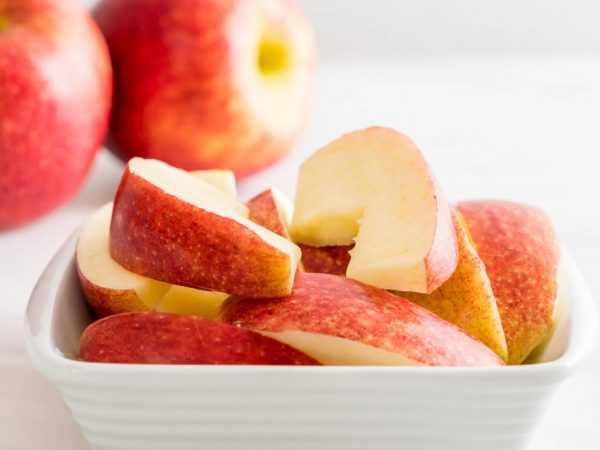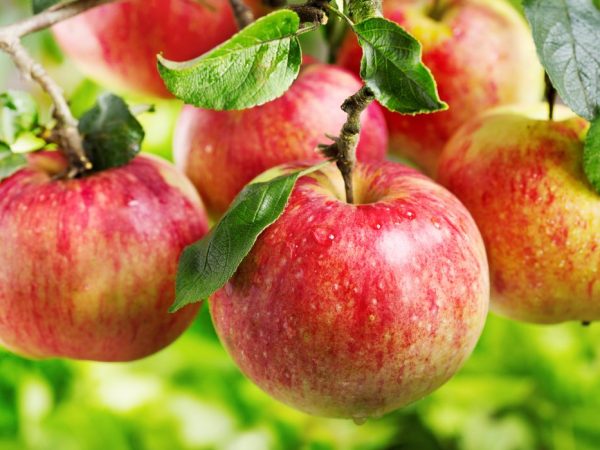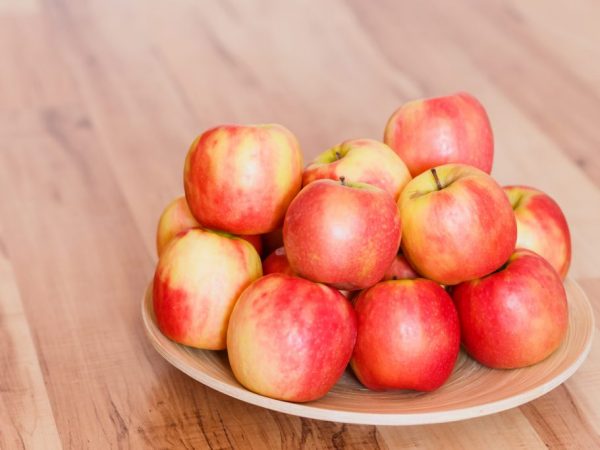Growing an apple tree Spartak
The Spartak apple tree was bred specifically for areas with a specific climate. This is a unique variety that has been appreciated by many gardeners, because withstands hot climates and does not need constant and intensive care.
- Characteristics of the variety
- Description of the tree
- Fruit characteristics
- Advantages and disadvantages of the variety
- Taste
- Yield
- Pollinating varieties
- Winter hardiness
- Disease resistance
- Landing
- Landing dates
- Technology
- Care
- Pest control
- Features of ripening and fruiting
- Harvesting and storage
- Growing regions
- Gardeners reviews

Growing an apple tree Spartak
Characteristics of the variety
Spartak is an autumn apple variety. It was bred in 1934 by the breeder Kedrin from the seeds of the Sharopai apple tree. The variety was created specifically for the Volga region, because due to special climatic conditions, not all fruit crops can take root there and produce a harvest. He has gained trust among gardeners and other regions.
Description of the tree
The trees are medium-sized, reaching a maximum height of 4-5 m. Their crown is dense and of an unusual round-pyramidal shape. The branches from the trunk generally branch off at a 90 ° or 45 ° angle, which is why they often break when ripening. This fact must be taken into account when forming the crown of a tree.
Fruiting in the variety is mixed, because it occurs on all types of fruit formations. The leaves of the tree are dark green and longitudinally oval. The tip is curled, but pointed. The edges are wavy, pointed, symmetrical. The base of the leaves is small and narrow. They are located at an angle of 45 °, do not bend.
Fruit characteristics
The fruits of the tree are medium. The mass of one is about 90-130 g, but in young trees they can often be up to 300 g. The shape of apples is round or flat-round, and the skin is not thick, dense and smooth, there is almost no plaque on it.
There are subcutaneous dots of white color, they are almost invisible. The color of the apples is yellowish green. Young fruits have a striped, unexpressed blush, while more mature fruits have a rich red. Apples are best picked at this time.
The peduncle is of medium thickness and length, emerging from a shallow funnel. The seeds of the fruit are light brown in color, ovoid, and the tip is not pointed. Usually there are many of them in an apple, and all are in closed or semi-open cells. The pulp is light green, with a creamy shade, fine-grained and juicy.
Advantages and disadvantages of the variety

Apples ripen quickly
Any kind of apple has its pros and cons. Spartak is characterized by the following advantages:
- he is fast-growing;
- has a high and regular yield;
- resistant to frost and drought;
- has good consumer qualities and transportability;
- lends itself to long-term storage.
There is also a drawback - the thermophilic type of tree has no immunity to scab.
Taste
Their flesh is dense, soft and juicy, has a pronounced sweet taste with a sour note. The peel of the fruit is characterized by a pleasant apple aroma. Experts for the taste of the fruit gave it a rating of 4.5 points out of 5.
Yield
The tree begins to bear fruit 3-4 years after planting. Young trees bear a large number of fruits every year.From a tree that is up to 8 years old, the yield per year will be from 14 to 29 kg, and from a tree from 10 years old - 50-95 kg.
Pollinating varieties
The description speaks of the self-pollination of the tree, but the fruit ovary in this case will be only 30%. Despite its self-fertility, gardeners plant other varieties of apple trees next to it, which help to carry out cross-pollination for 90% of fruit set. Such species for Spartacus are Idared, Umanskoe and Ruby Duki.
Winter hardiness
The tree was bred specifically for the Volga region. The temperature there is usually high, so the variety is well adapted to drought, but it has average resistance to frost. It normally withstands the cold only with proper care, and at a temperature of -25 ° C, the apple tree freezes and then does not recover well.
Disease resistance
Typically thermophilic trees have poor disease and pest resistance. The Spartak apple variety is no exception. If the weather is damp for a long time outside, then the tree and leaves are easily affected by scab. There are cases when apples are infected with fruit rot or cytosporosis, but they are quite rare.
Landing
In order for a tree to grow well and bring a rich harvest, it must be sown correctly. Proper planting is a good place, suitable soil, fertilization and timely watering.
Landing dates
For the Spartak apple tree, the best period for planting is early autumn or late winter. If frost is expected in the fall, close to sowing, then cultivation should be postponed until spring.
Technology
There are several factors to consider before planting.
Seedlings should be bought in proven places and the youngest should be chosen. Such trees take root better in new territory. If the seedling has dry leaves or twigs, they must be carefully removed and put into water for 4-5 hours.
Before planting, you need to calculate the size of the apple tree in advance. She must receive a sufficient amount of light - for this, each tree is planted 5 m from each other.
The pit is prepared in the fall a week before sowing. It is dug up to a depth of 1.5 m, with a diameter of 2 m. Fertilizers, for example, peat and necessarily nitrogen mixtures, must be poured onto the bottom. If the planting takes place in the fall - mineral fertilizer complexes. A week later, the seedling is placed in the ground, after having straightened the root system for it.
Then the roots are covered with earth. Gently tamp it, and the tree is watered abundantly immediately after planting.
Care

Apples will be very juicy with good watering.
The tree needs regular watering, at least 4 times a month. If it's dry and hot outside, you can water it more often. To saturate the root system with oxygen, loosening and weeding of the trunk circle is regularly carried out. In frost and cold weather, you need to cover the apple tree.
Another important point of care is tree feeding. For them, nitrogen and other mineral fertilizer complexes are selected. You can use natural, but pests develop quickly in them, so it is better to buy artificial feeding.
They are poured into special holes that are made by hand around the tree. In order for the fertilizers to be absorbed by the root system faster, the tree is watered with 2 liters of water.
The formation of the crown for this variety is especially important, because the branches of the Spartak apple tree tend to break from heavy fruits. The crown of the tree is thick and lush, pruning is carried out in the first year after it is planted.
Then all shoots are removed, leaving only 4 main branches, but shortening them to 3 buds. Then only dry or crooked branches are removed annually.
Pest control
Pests love to attack this apple tree. Breeders strongly oppose the use of chemicals to kill insects. There are many popular recipes that are good at fighting pests. Gardeners advise:
- to get rid of aphids on the branches, take black henbane. A dry plant is poured into 3 liters of water and brought to a boil.The cooled broth is again diluted with liquid so that a total of 10 liters come out, and the tree is sprayed;
- so that there are no caterpillars on the apple tree, a decoction of tomato tops is prepared. It is insisted for 5 hours in 10 liters of water, then boiled for 3 hours, filtered, allowed to cool and diluted with another 3 liters of water. After that, the tree can be sprayed with broth;
- to get rid of ants, just pour boiling water over their habitats.
Features of ripening and fruiting
The culture quickly brings the first fruits, ripening occurs 3-4 years after planting. In an apple tree, the formation of shoots is rapid, so fruiting always occurs with a high degree of yield. The fruits do not ripen at the same time. The first apples are usually harvested in early September. Harvesting can take 2-3 weeks.
Harvesting and storage
Fruits are always harvested at different times, but usually in September. 100 kg of apples are removed from one tree. They are well transported and can be stored for 2 months. Starting from mid-November, apples lose their taste and begin to taste bitter.
Growing regions
The variety was bred specifically for the Volga region, but now it is popular in other regions of Russia. It is grown in the suburbs, but the tree needs special care there. Spartak apple trees are whitewashed with lime 2 times a year, mulch the trunk circle with humus and cover it with roofing material so that it does not freeze.
The variety is also grown in central Russia, but there it can often become infected with scab, which is why the tree is sprayed with fungicides. In the south of the country, it takes root much better, because the climate there is warmer. For normal growth and high yields, the tree is regularly fed with various fertilizers.
The apple tree is also cultivated in the Urals. The soil there is completely different, it is more dense, so you need to provide the tree with a sufficient amount of oxygen by regularly loosening the soil around the seedling. Another region where the variety is grown is the Kirov region. There, the tree needs feeding from humus and compost.
Gardeners reviews
According to gardeners, the tree is picky and easy to maintain. If you plant properly, water and feed the apple tree regularly, it grows beautiful and neat. The main thing is that it gives a high yield and has a pleasant sweet taste and rich aroma, due to which it is in high demand among buyers.

